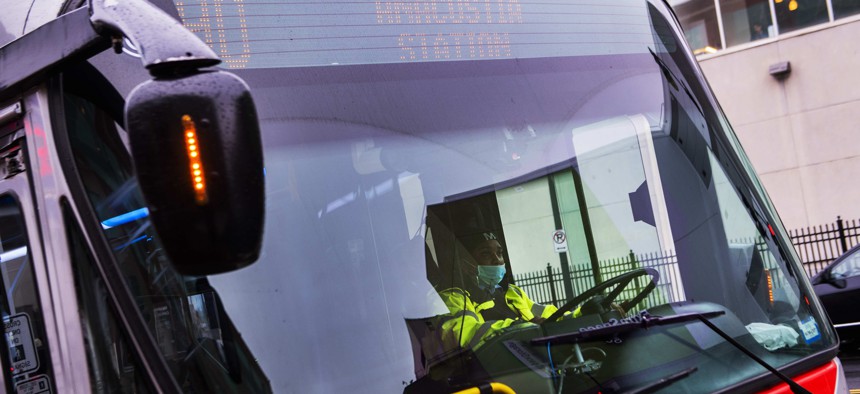D.C. Would be Biggest City Yet to Make Bus Rides Free

A WMATA bus travels on Florida Avenue, NE, in Washington, D.C. Tom Williams/CQ-Roll Call, Inc via Getty Images
The Washington, D.C. Council is set to vote on a plan next week that would drop the $2 fare for riders on the local bus system. It mirrors programs smaller U.S. cities have adopted in recent years.
The nation’s capital could soon become the biggest city in the country to let residents ride local buses for free, the chair of the Washington, D.C., city council said Thursday.
A handful of smaller cities – like Kansas City, Missouri or Olympia, Washington – already have rolled out free fares. The city of Arlington, Virginia, across the Potomac River from D.C., recently eliminated fares on its bus system. And Boston, which has a population roughly the same as D.C.’s, has tried it on a limited basis. All told, 42 other U.S. jurisdictions offer free rides or provide subsidies for lower-income residents.
But the D.C. proposal also goes beyond free rides.
Phil Mendelson, the council chair, unveiled the ambitious proposal with fellow councilmember Charles Allen ahead of a vote next week. Ten of the 13 members of the council are sponsoring the measure.
They want to make it free to ride local Metro buses in D.C., which now costs $2 a ride. They would later give all city residents up to $100 a month to use on the local subway system or on buses in the Maryland and Virginia suburbs that use the same fare card.
Their proposal would also provide funding to run overnight service on 12 popular bus routes. It would include $10 million to improve bus stops and add bus lanes. The free rides would take effect in July, while the $100 payments would begin the following year.
“This is a big deal,” Mendelson said in a statement. “This will be [a] game changer for bus users [including] reliable schedules and faster boarding.” He predicted the changes would boost ridership on the bus system, reduce road congestion, lower pollution and help stabilize the finances of the beleaguered Washington Metropolitan Area Transit Authority.
The multipronged approach addresses some of the concerns that advocates have had about free-fare programs in other places, particularly that the money could be better spent on improving service rather than removing fares.
But making bus service free would also cost less, at $43 million a year, than Allen’s original proposal to offer a broader subsidy that would have cost $150 million annually.
The free bus trips would apply to everyone in the city, but they will likely most help low-income residents and residents of minority communities. Sixty percent of D.C. residents who ride the bus are Black, while 60% of D.C. residents who use rail are white, according to a council analysis.
“Public transit’s a public good. I’m not going to means-test your sidewalk, or your library, or your school. It also costs an incredible amount of money to create a means-tested program. When 70% of bus riders are earning less than $50,000 a year, we don’t need to do a lot of complicated math,” said Allen, who has been pushing similar measures for three years, at a press conference Thursday.
Focusing on bus, rather than rail, also makes the proposal more straightforward to administer at a regional level. Under the proposal, the District government would pay the cost of the bus fares directly to WMATA for any passenger who boards within the city. Although some routes cross into Maryland and Virginia, the vast majority are contained within D.C
WMATA’s rail lines, on the other hand, have a much farther reach. Almost all of them begin and end in the suburbs. They serve as both a local network for D.C. residents and a regional commuter system that ferries Virginia and Maryland residents into downtown D.C. for work. The rail system has been plagued in recent years by equipment failures, lax safety procedures and a daunting financial picture, even as it opened an extension to Dulles International Airport in the distant suburbs last month.
The transit agency said it appreciated the council’s “leadership and commitment to making transit more accessible for our customers. These are big, bold concepts that will encourage ridership throughout the region.”
Daniel C. Vock is a senior reporter for Route Fifty based in Washington, D.C.
NEXT STORY: Covering the gaps left by the silver tsunami






